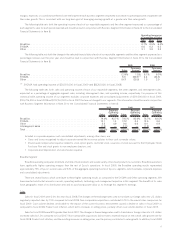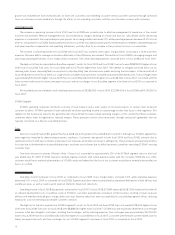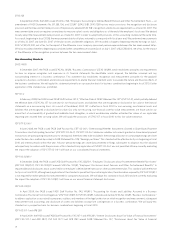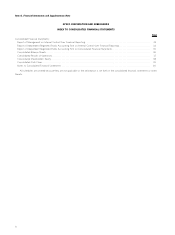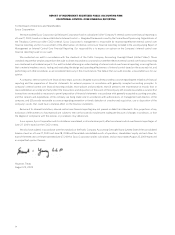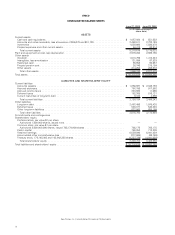Sysco 2009 Annual Report Download - page 46
Download and view the complete annual report
Please find page 46 of the 2009 Sysco annual report below. You can navigate through the pages in the report by either clicking on the pages listed below, or by using the keyword search tool below to find specific information within the annual report.recognize these as a reduction of cost of sales when the earnings process is complete, the related service is performed and the amounts realized. In
certain of these latter instances, the vendor consideration represents a reimbursement of a specific incremental identifiable cost incurred by Sysco.
In these cases, we classify the consideration as a reduction of those costs with any excess funds classified as a reduction of cost of sales and
recognize these in the period in which the costs are incurred and related services performed.
Goodwill and Intangible Assets
Goodwill and intangible assets represent the excess of consideration paid over the fair value of tangible net assets acquired. Certain
assumptions and estimates are employed in determining the fair value of assets acquired, including goodwill and other intangible assets, as well as
determining the allocation of goodwill to the appropriate reporting unit.
In addition, annually or more frequently as needed, we assess the recoverability of goodwill and indefinite-lived intangibles by determining
whether the fair values of the applicable reporting units exceed the carrying values of these assets. The reporting units used in assessing goodwill
impairment are our six operating segments as described in Note 20, Business Segment Information, to the Consolidated Financial Statements in
Item 8. The components within each of our six operating segments have similar economic characteristics and therefore are aggregated into six
reporting units.
We arrive at our estimates of fair value using a combination of discounted cash flow and earnings multiple models. The results from each of
these models are then weighted and combined into a single estimate of fair value for each of our six operating segments. The primary assumptions
used in these various models include estimated earnings multiples of comparable acquisitions in the industry including control premiums, earnings
multiples on acquisitions completed by Sysco in the past, future cash flow estimates of the reporting units, which are dependent on internal forecasts
and projected growth rates, and weighted average cost of capital, along with working capital and capital expenditure requirements. We update our
projections used in our discounted cash flow model based on historical performance and changing business conditions for each of our reporting
units.
Actual results could differ from these assumptions and projections, resulting in the company revising its assumptions and, if required,
recognizing an impairment loss. There were no impairments of goodwill or indefinite-lived intangibles recorded in fiscal 2009, 2008 or 2007. Our
past estimates of fair value for fiscal 2009, 2008 and 2007 have not been materially different when revised to include subsequent years’ actual
results. Sysco has not made any material changes in its impairment assessment methodology during the past three fiscal years. We do not believe
the estimates used in the analysis are reasonably likely to change materially in the future but we will continue to assess the estimates in the future
based on the expectations of the reporting units. In fiscal 2009, the reporting units’ fair values would have had to have been lower by 16% compared
to the fair values estimated in our impairment analysis before additional analysis would have been indicated to determine if an impairment existed for
any of our reporting units.
The Other (specialty produce, custom-cut meat, lodging industry products and international distribution operations) operating segments have
a greater proportion of goodwill recorded to estimated fair value as compared to the Broadline or SYGMA reporting units. This is primarily due to
these businesses having been recently acquired, and as a result there has been less history of organic growth than in the Broadline and SYGMA
segments. In addition, these businesses also have lower levels of cash flow than the Broadline segment. As such, these Other operating segments
have a greater risk of future impairment if their operations were to suffer a significant downturn.
Share-Based Compensation
We provide compensation benefits to employees and non-employee directors under several share-based payment arrangements including
various employee stock incentive plans, the Employees’ Stock Purchase Plan, the Management Incentive Plan and various non-employee director
plans.
As of June 27, 2009, there was $63,746,000 of total unrecognized compensation cost related to share-based compensation arrangements.
That cost is expected to be recognized over a weighted-average period of 2.97 years.
The fair value of each option award is estimated on the date of grant using a Black-Scholes option pricing model. Expected volatility is based on
historical volatility of Sysco’s stock, implied volatilities from traded options on Sysco’s stock and other factors. We utilize historical data to estimate
option exercise and employee termination behavior within the valuation model; separate groups of employees that have similar historical exercise
behavior are considered separately for valuation purposes. Expected dividend yield is estimated based on the historical pattern of dividends and the
average stock price for the year preceding the option grant. The risk-free rate for the expected term of the option is based on the U.S. Treasury yield
curve in effect at the time of grant.
The fair value of the stock issued under the Employee Stock Purchase Plan is calculated as the difference between the stock price and the
employee purchase price. The fair value of restricted stock granted to employees is based on the stock price on grant date. The application of a
discount to the fair value of a restricted stock grant is dependent upon whether or not each individual grant contains a post-vesting restriction. The
fair value of the stock issued under the Management Incentive Plans with respect to years prior to fiscal 2009 was based on the stock price on the
last day of the fiscal year less a 12% discount for post-vesting restrictions. The discount for post-vesting restrictions was estimated based on
restricted stock studies and by calculating the cost of a hypothetical protective put option over the restriction period.The stock award component of
the Management Incentive Plan bonus awards was removed beginning in fiscal 2009.
26



